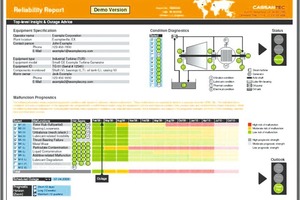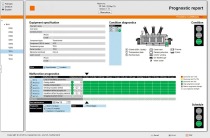Lower cost and higher planning security for the cement industry
Operators of industrial equipment like cement plants often need to make decisions that relate to the future. They usually plan their maintenance schedules in regular intervals, based on manufacturer instructions enhanced by past experience. Maintenance often is planned in advance for the entire year. Decisions concerning the maintenance plan for a cement plant can be greatly improved through prognostics. The currently used information is not future-oriented, i.e. it is not prognostic. This costs millions every year. Previous attempts at addressing this problem were insufficient, even if they may be regarded as highly advanced, says Cassantec, an independent provider of automated prognostics offerings for industrial asset management from Zurich, Switzerland.
Predictive Diagnostics yields early warnings for future equipment malfunctions. However, some critical information is still missing: When will the time window close during which proactive measures can be employed? Nowadays, with new technologies such as the Internet of Things and Big Data Analytics, collecting condition data has become the norm in most enterprises. Through condition monitoring plant operators hope to reduce the downtime of their cement plant. By using condition as well as process data, for example, temperature or oil analyses, these established approaches of condition monitoring provide important information on critical components of a cement plant.
Generally, the consolidation and interpretation of such data is an extremely demanding task since different condition monitoring and diagnostics technologies will look at different operational aspects and address different types of malfunction. Moreover, they merely describe the current condition of a component without any specific reference to the future. Hence, these analyses provide the plant operator with answers to many questions. He can see why the plant condition is critical and which components can be expected to experience a malfunction. Thus he knows where proactive intervention is necessary. Condition monitoring does not, however, answer questions concerning the time frame, i.e. it does not answer the “when” question.
Cassantec Prognostics fills this information gap by introducing an explicit future horizon. Advanced algorithms forecast the probable occurrence of events, and hence also when the time window for proactive countermeasures will close. Equipped with that information, maintenance schedules can be improved and unnecessary costs or unscheduled downtimes avoided.
In an exemplary cement plant producing around 1.8 million tonnes of cement per year, the budget for maintenance is estimated at around 7.3 million euros per year. Thanks to the prognostic approach that facilitates an optimized maintenance schedule between 25 and 30 percent of maintenance costs can be saved as the number of unplanned outages is minimized. Unscheduled downtimes of around 40 days can thus be reduced to approximately 32 to 33 days, lowering maintenance costs to 5.1 to 5.5 million euros. Following a prognostic approach, unscheduled downtimes can be reduced by around 30 percent. In addition, technically unnecessary maintenance operations can be avoided and maintenance interventions intelligently combined.
Since the forecasts are individually calculated for each component, they are not based on fleet averages or generic manufacturer information. The prognosis incorporates individual performance curves, the operational strategy and, where appropriate, earlier incidents. Consequently, by this way the prognosis will reach a high level of accuracy and reliability. In the prognosis calculation, historical and current data runs through a number of processing stages consisting of stochastic methods and highly developed algorithms. The result is an explicit risk profile illustrating the likelihood of malfunctions over a specific time horizon.
With its efficient configuration process and highly scalable Prognostic Reports, Cassantec Prognostics delivers enormous economic advantages: equipment downtimes can be minimised by reduced unscheduled downtimes, conducting maintenance interventions only when technically warranted and by intelligently bundling interventions. Furthermore, the Remaining Useful Life of the equipment can be actively managed by adjusting operations on the basis of the transparent information provided by the Prognostic Report.
//www.cassantec.com" target="_blank" >www.cassantec.com:www.cassantec.com






